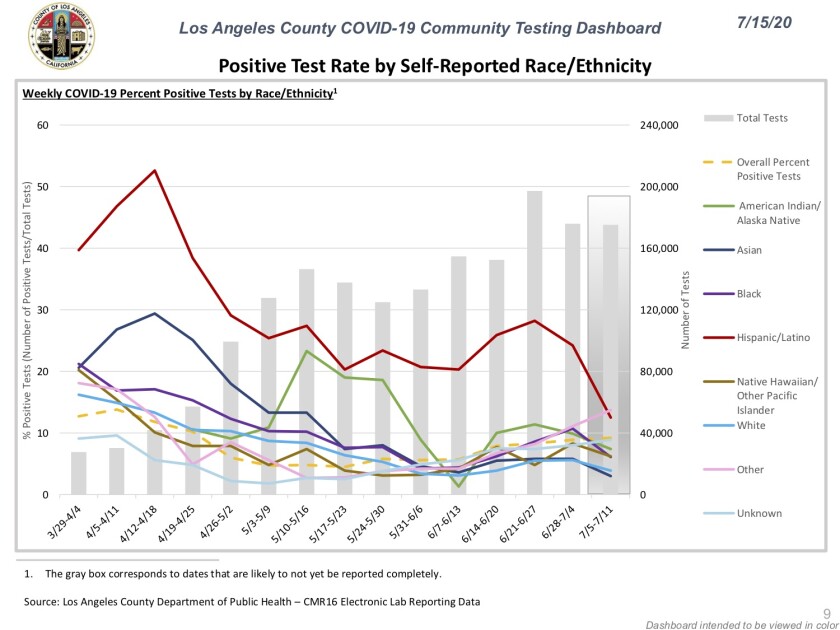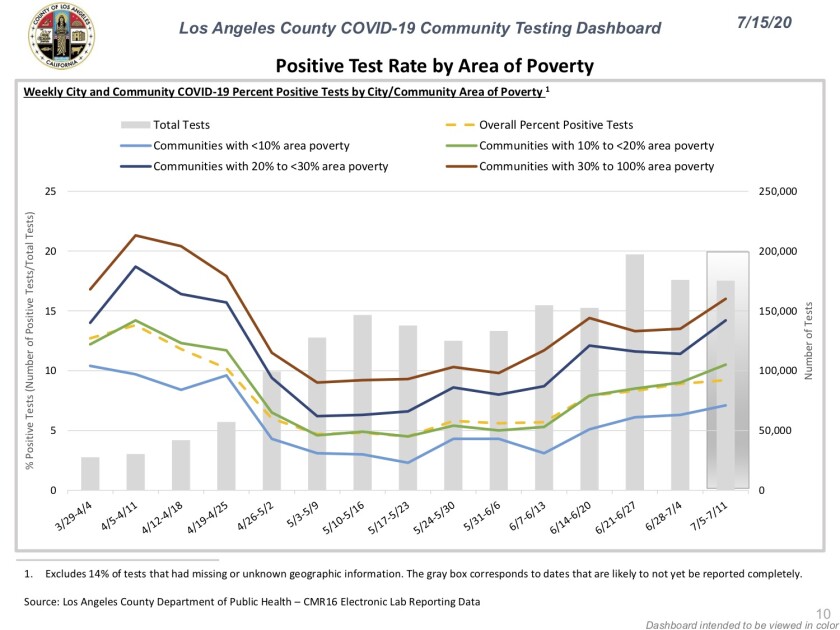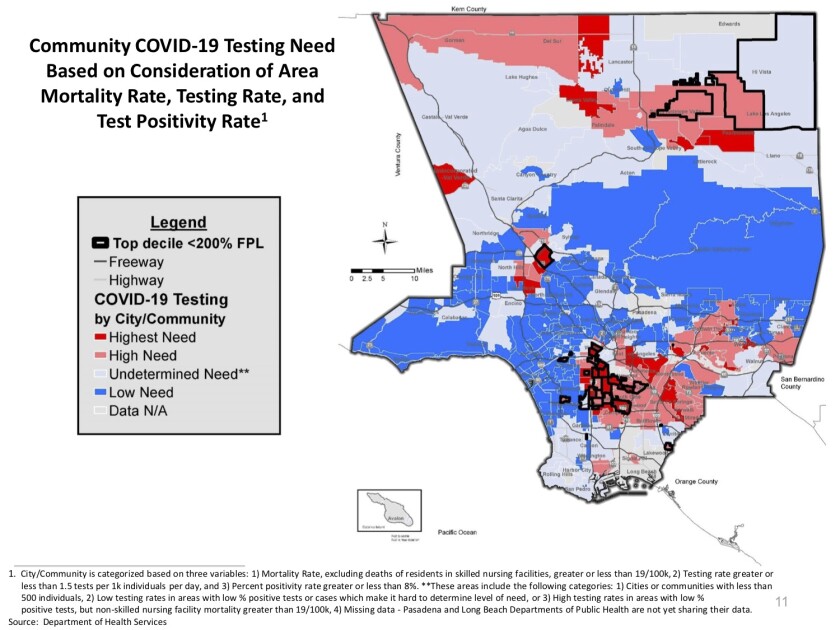The next two weeks are shaping up to be critical for California as officials wait to see if the sweeping restrictions imposed in late June and July show any signs of slowing the rapid spread of coronavirus in communities across the state.
This week was marked by a series of grim milestones as California shattered a one-day record for new coronavirus cases — more than 11,000 on Tuesday — as well as rising infection rates and growing numbers of hospitalizations. Because the coronavirus can take weeks to incubate, much of the current surge is still tied to people exposed to the virus in June, as counties rapidly reopened the economy and many returned to old but now dangerous routines such as bar-hopping and attending parties and other social events. Many also returned to workplaces that didn’t implement new safety protocols.
The big question now is whether Californians changed their behavior enough in July to reduce infection rates. Officials began raising alarms in the days before the July 4 holiday and over the last few weeks have closed bars, indoor dining, shopping malls, gyms and other retail establishments in many areas.
“It’s kind of in everybody’s hands right now,” said Barbara Ferrer, director of public health for L.A. County. “We don’t have a lot of time, though. At some point, you turn that corner where you’re actually expecting hospitals to provide way more care than is possible.”
On June 28, Gov. Gavin Newsom ordered bars shut in L.A. County and several others, and a day later, Ferrer warned of “alarming increases in cases, positivity rates and hospitalization.” By July 1, Newsom ordered indoor restaurant dining and bars closed in 19 counties, affecting 72% of the state’s population.
It has been about two weeks since then, but it’ll take at least three weeks to learn whether the actions taken that week decisively changed the course of the pandemic, said Dr. Christina Ghaly, director of health services for Los Angeles County. Ghaly said Wednesday that if people got back to safer behavior — staying home as much as possible, avoiding social gatherings, wearing face coverings, keeping physical distance and workplaces following new safety protocols — L.A. County could avoid having hospitals and ICUs overwhelmed.
Even more businesses have shut down this week, with Newsom ordering the closure of all bars and indoor dining rooms at restaurants. And in the hardest-hit counties that are home to more than 88% of Californians, he also closed indoor operations of gyms, places of worship, hair salons, nail salons, malls, tattoo parlors, bowling alleys, arcades and offices for nonessential industries.
If one thing is clear, officials across the state said, it’s now up to residents and businesses to do their best to slow the spread of disease. The percentage of younger adults getting infected with the coronavirus is growing, and younger adults are now making up a larger share of hospitalized COVID-19 patients, making up nearly 30% of them in L.A. County.
“Birthday parties, the visits with grandparents … the barbecues: they are contributing to a delay or rollback in reopening of businesses,” said Dr. Grant Colfax, San Francisco’s public health director.
California on Tuesday recorded its highest number of new cases in a single day, 11,142 infections; Tuesday also marked the second-highest number of deaths in a single day statewide, with 144 deaths tallied, according to the Los Angeles Times’ California coronavirus tracker.
On Wednesday, at least another 8,000 new coronavirus cases and more than 125 deaths were reported statewide.
There have been a cumulative total of more than 354,000 confirmed cases and more than 7,300 deaths related to the coronavirus statewide. Of them, more than 143,000 cases and more than 3,900 deaths have occurred among L.A. County residents.
More than 6,700 people with confirmed coronavirus infections were in the hospital statewide Tuesday. That’s more than double the daily average in May, when there were about 3,000 people hospitalized statewide with confirmed infections.
In L.A. County, officials estimated that the effective transmission rate of the coronavirus has risen slightly to 1.07, according to data released Wednesday, although the actual number could be anywhere from 0.94 to 1.2. That means officials estimate that on average, every 1 person infected with the virus transmits it to 1.07 other people.
San Francisco on Wednesday reported an even worse transmission rate of about 1.3.
“The virus is not only still out there, it is out there more than ever before,” said Colfax, the city’s public health director. “If we do not do better, we are looking at major problems by late August and September, with an average peak of 900 hospitalized patients by early October” — a number 10 times as bad as what the city is seeing now.
Colfax said it’s “certainly possible” that if conditions do not improve, officials may need to roll back reopening efforts in San Francisco and the greater Bay Area.
With evidence mounting about the disproportionate impact the pandemic is having on Latino and Black communities, L.A. County officials Wednesday announced plans to expand testing where it’s most needed.
Officials announced they will open six new testing sites in communities of color — Montebello, South Gate, Azusa, Panorama City, Compton and the Downey-Norwalk area. And they will add capacity at four existing sites in Bellflower, Pomona, El Monte and East Los Angeles.
An astonishing 89% of people testing positive for the coronavirus at a site in Willowbrook, south of Watts, have been Latino, even though 71% of those who were tested identified themselves Latino, said Dr. Erika Flores Uribe, an emergency room physician and the director of language access and inclusion at the county’s health services department.
The result is close to that of a study in San Francisco’s Mission District, in which 95% of people testing positive for the coronavirus were Latino.
Furthermore, Latino residents are testing positive at a much higher rate than any other racial or ethnic group in Los Angeles County, a trend that has been constant for months, said Ghaly, the L.A. County health services director.



Latino residents are testing positive at a much higher rate than any other racial or ethnic group in Los Angeles County
(Los Angeles County Department of Health Services)
The disparity could be reflective of white residents having less risk of being exposed to the coronavirus.
White residents are less likely to live in crowded households or work in essential jobs that require employees to leave home to earn money, Ghaly said. The disparity in the so-called positivity rate could also reflect greater access to and use of testing resources by white residents.
“Sadly, the underlying reasons why communities of color are disproportionately impacted by the worst outcomes of COVID-19 is related to longstanding structural and systemic issues, including social determinants of health that the county is working to address and mitigate in the midst of this pandemic,” Ghaly said.
Poverty also increases the risk of testing positive.



Poverty also increases the risk of testing positive. In communities with the highest poverty rates, more than 15% of coronavirus tests had results confirming infection; in the wealthiest neighborhoods, less than 8% of tests came back positive.
(Los Angeles County Department of Health Services)
“This reflects, again, the burden that our low income communities face in terms of their exposure to the virus, and also the fact that they were not — and still are not — accessing testing at an appropriate level given their degree of burden,” Ghaly said.
To figure out where the county should add testing sites, officials did an analysis to create a map of areas of L.A. County that had the greatest need for more coronavirus testing, based off of factors like the positivity rate, the coronavirus mortality rate, and the rate at which residents are accessing testing services.
The results showed portions of South Los Angeles, Southeast L.A. County, the San Gabriel Valley, the Pomona Valley, the San Fernando Valley and the Antelope Valley needed greater access to testing.



L.A. County officials released a map showing areas (in red) in highest need of additional resources to test for the coronavirus.
(Los Angeles County Department of Health Services)

